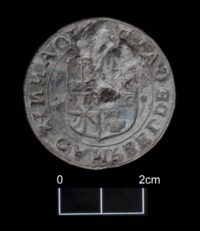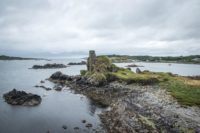 An excavation at the ruins of Dunyvaig Castle on Islay, in Argyll, Scotland, has unearthed a rare 17th century artifact: the seal of Sir John Campbell of Cawdor. The lead seal bears the Cawdor coat of arms with a stag head and a galley on the obverse, and is inscribed “IOANNIS CAMPBELL DE CALDER.” On the reverse is the date 1593 and the initials DM.
An excavation at the ruins of Dunyvaig Castle on Islay, in Argyll, Scotland, has unearthed a rare 17th century artifact: the seal of Sir John Campbell of Cawdor. The lead seal bears the Cawdor coat of arms with a stag head and a galley on the obverse, and is inscribed “IOANNIS CAMPBELL DE CALDER.” On the reverse is the date 1593 and the initials DM.
 It was a student who found the object. University of Reading undergraduate Zoë Wiacek was one of a team of 40 archaeologists, other scientists and students who have been excavating the site for three weeks as part of a yearly summer school dig on the island. Towards the end of the dig, Wiacek discovered the seal under the rubble of a collapsed stone wall. She realized it was significant but did not know what it was. When the lead circle was removed and the soil brushed off, the inscription identifying it as Sir John’s seal was revealed.
It was a student who found the object. University of Reading undergraduate Zoë Wiacek was one of a team of 40 archaeologists, other scientists and students who have been excavating the site for three weeks as part of a yearly summer school dig on the island. Towards the end of the dig, Wiacek discovered the seal under the rubble of a collapsed stone wall. She realized it was significant but did not know what it was. When the lead circle was removed and the soil brushed off, the inscription identifying it as Sir John’s seal was revealed.
 Originally built in the 13th century, very little of the original structure remains. What’s left today is largely the 16th century castle built by the Clan MacDonald of Dunnyveg. Sir John Campbell came to own it several decades later in 1612, when Angus MacDonald sold him Dunyvaig and several other family holdings on Islay. Some of the MacDonald family were not in agreement with the laird’s choice. They occupied the castle and made Cawdor fight for it. He didn’t take possession until 1615.
Originally built in the 13th century, very little of the original structure remains. What’s left today is largely the 16th century castle built by the Clan MacDonald of Dunnyveg. Sir John Campbell came to own it several decades later in 1612, when Angus MacDonald sold him Dunyvaig and several other family holdings on Islay. Some of the MacDonald family were not in agreement with the laird’s choice. They occupied the castle and made Cawdor fight for it. He didn’t take possession until 1615.
Given the date of the seal, it’s possible it was lost during those three years of sieges and battles. It could also have been lost in the chaos of another fight 30 years later. In 1646, MacDonald descendant Alasdair MacColla took the castle, leaving his 76-year-old father Colla Ciotach in charge of defending it against the inevitable Campbell counterattack. He did the best he could, erecting new turf walls over the collapsed masonry walls and holding on to the castle until 1647 when he was defeated and executed by hanging from the castle walls.
Sir John Campbell of Cawdor was dead by then, however. He died in 1642. If the seal was lost in the 1646 raid, it would have been an heirloom rather than a legal signature.
Archaeologist Dr Darko Maricevic, director of the excavation at Dunyvaig, said: “This is a remarkable find. Not only is it a beautiful and well-preserved object, but it comes from the floor of a building that we can now confidently date to the Campbell occupation.
“So buried below this floor, we will have the story of the MacDonald’s – the Lords of the Isles – to reveal.”
Roddy Regan, an archaeologist at Kilmartin Museum, added: “Seals are extremely rare finds. This discovery conjures up an image of a Campbell garrison fleeing from the castle when under attack, dropping and losing one of their most precious items, or maybe the seal had once been hidden within a wall niche and long forgotten.”